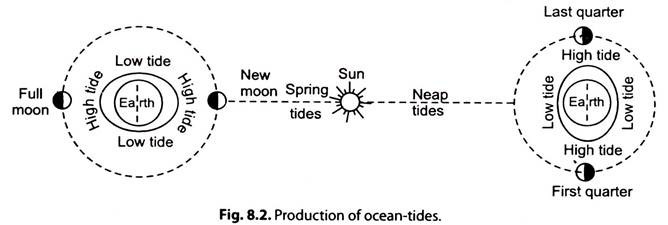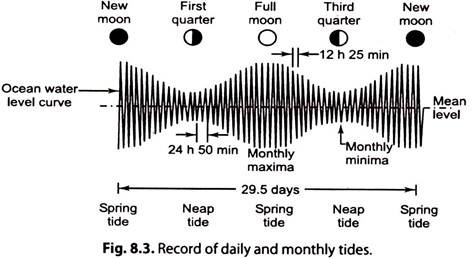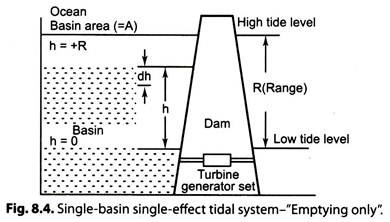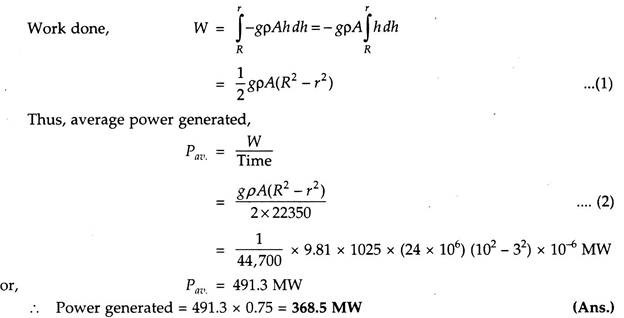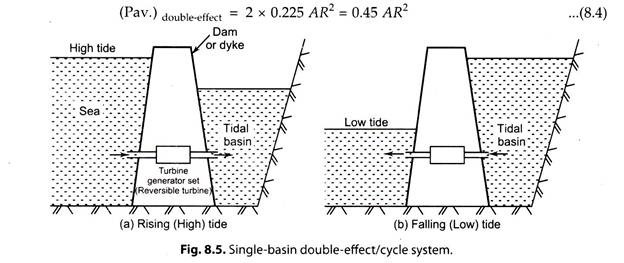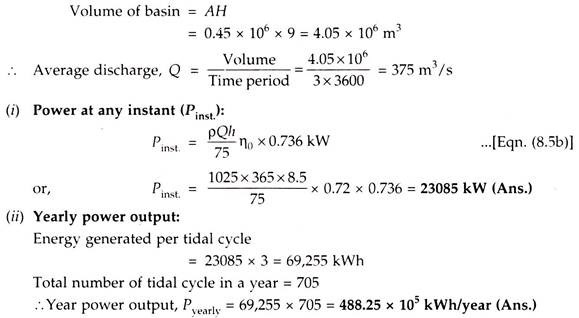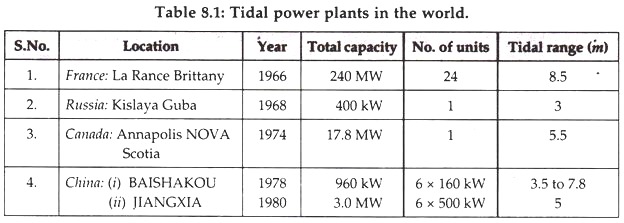Are you looking for an essay on ‘Tidal Energy’? Find paragraphs, long and short essays on ‘Tidal Energy’ especially written for school and college students.
Essay on Tidal Energy
Essay Contents:
- Essay on the Introduction to Tidal Energy
- Essay on Tidal Range (R)
- Essay on the Production of Ocean-Tides
- Essay on the Origin of Tides (Tidal Phenomenon)
- Essay on the Estimation of Energy Potential for a Tidal Power Project
- Essay on the Power Generation (Yearly) From Tidal Plants
- Essay on the Site Requirements for a Tidal Power Scheme
- Essay on the Components of a Tidal Power Plant
- Essay on the Advantages and Disadvantages of Tidal Power
- Essay on the Global Scenario of Tidal Energy
- Essay on the Economic Aspects of Tidal Energy Conversion
Essay # 1. Introduction to Tidal Energy:
The periodic rise and fall of the water level of sea which are carried by the action of the sun and moon on water of the earth is called the ‘tide’.
The daily variation in tidal level is mainly due to the changing position of the moon:
i. Tidal energy can furnish a significant portion of all such energies which are renewable in nature. The large scale up and down movement of sea water represents an unlimited source of energy. If some part of this vast energy can be converted into electrical energy, it would be an important source of hydropower.
ii. The main feature of the tidal cycle is the difference in water surface elevations at the high tide and at the low tide. If this differential head could be utilized in operating a hydraulic turbine, the tidal energy could be converted into electrical energy by means of an attached generator.
Essay # 2. Tidal Range (R):
The tidal range is the difference between consecutive high tide and low tide water level. It is denoted by R and is measured in metres.
Tidal energy refers to the potential energy in the tidal range.
Fig. 8.1 shows the time versus water-level characteristics of ocean tide for a lunar day. The tidal curve against time is approximately sinusoidal. Range (R) is the difference in water level of high-tide crest and low-tide crest. This difference is utilised to obtain the head of water between ocean-side and basin-side of the barrage (dam).
Tidal range (amplitude) varies widely depending upon geographical location, contour of ocean bed, depth of oceans, distance from coasts etc. It is insignificant in the middle of ocean and significant near coast. Tidal ranges of 0.25 m to 17 m have been recorded in different locations.
Tidal range is not constant at the same collection but varies with lunar days in the month. A lunar month is of 29.5 days.
Essay # 3. Production of Ocean-Tides:
Fig. 8.2 explains how ocean-tides are produced.
Spring tides are those in which the tidal range is maximum on full moon and new moon.
The tides in which the tidal range is minimum on first quarter and third quarter are called Neaptides.
Fig. 8.3 shows a record of daily and monthly tides in a complete lunar month.
Daily cycle is due to rotation of earth about its axis producing two crests and two ebbs in one lunar day (Fig. 8.1).
Monthly cycle is of two maximas and two minimas in one lunar month of 29.5 days. This cycle is due to changing position of the moon and sun with one revolution of the moon around the earth.
The tidal range has a typical daily variation superimposed on a monthly variation.
Essay # 4. Origin of Tides (Tidal Phenomenon):
The tidal energy is due to the gravitational force of attraction between the earth and sun and between earth and moon.
The gravitational force F between two bodies, say between sun and a molecule on earth, is given by:
Where M = Mass of sun,
m = Mass of water molecule,
d = Distance between sun and water molecule, and
K = Gravitational constant.
The gravitational force between moon and a water molecule will also be given by a similar equation. Since distance between moon and earth is lesser than that between sun and earth, the attraction between moon and water molecule is about 2 to 3 times that between sun and molecule.
i. The moon revolves around the earth with a period of 24 hours 50 minutes per one revolution. The earth’s surface facing the moon experiences greater attractive force than the surface away from the moon. Thus ocean water on the moon side experiences a swell (hide tide) and the other side experiences low tide. Such daily tides are called the diurnal tides (Fig. 8.3)
ii. The relative positions of the sun, the moon and the earth have hourly variation, daily variation. Hence tides are affected by these relative positions. Spring tides and Neap tides are caused by relative positions of the moon and the sun with respect to the position of ocean on the earth surface (Fig. 8.3).
Essay # 5. Estimation of Energy Potential for a Tidal Power Project:
To utilise tidal energy, water must be trapped at high side behind a dam or barrage and then made to drive turbine as it returns to sea during low side. The available energy is proportional to the square of the amplitude of tide. As such the available energy tends to be concentrated around regions of high side. The amount of generation depends only on the tidal phenomenon and can be predicted fairly accurately.
Because of the variations in tidal pattern, the power output shows some variations as under:
A. Two bursts of generation activity per day, beginning about 3 hours before high tide and lasting from 4 to 6 hours.
B. The power output in each tidal cycle will increase with the difference between high and low tides. Thus the power output curve will display a 14 day cycle.
C. The high tide time shifts by about one hour every day and the power output will show a similar shift.
D. Spring tide high water always occurs at the same time. Thus the maximum availability will not be disturbed evenly during the day.
Tidal power schemes are of two types:
1. Single basin scheme.
2. Two basin scheme.
Energy and Power in a Single-Basin Single-Effect/Cycle Scheme:
A single basin scheme is cheaper. However it is not very useful due to the above mentioned reasons in power output. This scheme produces power output, which follows phases of sun and moon and not the load demand of the system. Therefore, a single basin tidal power scheme would always need a standby plant.
Fig. 8.4 shows a single-basin single-effect tidal power scheme. It is the case of basin beginning at high-tide level, emptying through the turbine to ocean, which is at ‘low tide’; head (h) varying from (+R) to 0.
In case of a ‘Double cycle system’, power is generated while “filling” the basin and also while “emptying” the basin. Hence double cycle scheme gives “double energy” per tide cycle of one crest and one ebb.
Let,
A = Area of basin, considered constant, m2,
p = Density of water, kg/m3,
g = Gravitational constant,
m = Mass flowing through the turbine, kg,
h = Head, m, and
W = Work done by water flowing through turbine, J.
For tidal range (amplitude) R, and certain head (h) at the given time during the flow from the ocean to basin, the differential work done (dW) is equal to the change in potential energy due to change in mass (dm) of water. Hence,
dW = dm.g.h, J
But, dm = – p.A.dh
(-ve sign indicates decrease in the mass of water during in emptying operation)
So, that dW = -p.A.dh.g.h, J
The total work done (W) by water while emptying the basin is obtained by integrating dW from R to 0,
Eqn. (8.2) indicates that work is proportional at to square of the tidal range.
The power is the rate of doing work.
The power is generated during emptying (or filling) and no power is generated during rest of the time.
The average power generated is calculated based on average operating head of R/2 which is available only for limited period under a single-basin emptying operation. There are friction losses, conversion efficiencies of the turbine and generator that reduce the power. Studies have shown that the optimal annual energy production is about 30 percent of the average theoretical power.
Example 1:
A tidal power plant of single-basin type, has a basin area of 24 km2. The tide has a range of 10 m. The turbine stops operation when the head on it falls below 3m. Calculate the average power generated during one filling/emptying process in MW if the turbine-generator efficiency is 75 percent. Density of sea water = 1025 kg/m3; g = 9.8 m/s2.
Solution:
Given- A = 24 km2 = 24 x 106 m2; R = 10 m; r = 3 m (the heat before turbine stops operating); η = 0.75; p = 1025 kg/m3; g = 9.81 m/s2.
Average power generated, Pav:
Energy and Power in a Single-Basin Double-Effect/Cycle Scheme:
Fig. 6.5 shows a single-basin double-effect/cycle tidal power system. In this system energy is converted into electrical energy during flood tide (rising tide) when the basin is filled and also during the ebb tide (falling tide) when the basin is emptied. Since water flows through the turbine during rising and falling tides in apposite directions, therefore, a reversible turbine is used, which acts as a turbine for either direction of flow.
The average theoretical power from a double-cycle/effect scheme is twice that of a similar single-effect scheme. Thus, the theoretical average power generated (using eqn. 8.3).
This system is 100 percent more efficient that single-effect system/plant because it generates double energy per cycle.
Essay # 6. Power Generation (Yearly) From Tidal Plants:
The energy available from a tidal plant depends on the following two factors:
(i) The tidal range.
(ii) The volume of water accumulated in the basin.
Tidal energy is slowly-increasing hydro-energy during filling of the basin, and after a period of nearly 3 hours it attains its peak value. When the tide recedes, water is allowed to flow from basin to sea; it is then slowly-decreasing hydro-energy and attains its lowest value when the turbine stops after a period of 3 hours. Thus, the energy available for a tidal point can be calculated in a similar way as for an hydropower plant; i.e., considering the average discharge and available head at any instant.
Let, A = Average cross-sectional area of the basin, m3
H = Difference between maximum and minimum water levels, m, and
V = Volume of basin, m3.
Now, V = AH
∴ Average discharge, Q = AH/t
where t is the total duration of generation in one filling/emptying operation in seconds.
Now, power generated at any instant,
Example 1. For a proposed tidal site, the observed difference between high and low water tide is 9 m. The basin area is about 0.45 sq. km which can generate power for 3 hours in each cycle. The average available head is assumed to be 8.5 m, and overall efficiency of the generation is 72 percent. Assume density of sea water as 1025 kg/m3.
Calculate:
(i) Power at any instant.
(ii) Yearly power output.
Solution:
Given- H = 9 m; A = 0.45 x 106 m2; t = 3 hours; h = 8.5 m; η0 = 72%, p = 1025 kg/m3.
Essay # 7. Site Requirements for a Tidal Power Scheme:
A favourable site for tide power scheme should meet with the following requirements:
1. The site should have a large tidal range.
2. Capable of storing a large quantity of water for energy production with minimum dam and dyke construction.
3. To achieve a high storage capacity, the site should be located in an estuary or a creek.
4. It should be near to a load centre to minimise the transmission requirements.
The following points need to be considered prior to the development of a tidal power scheme:
1. Pre-Feasibility Study:
It pertains to the collection of data such as tides, local topography, infrastructure, etc.
During this study following should be collected:
(i) Local land area map, survey of India map and hydrographic charts,
(ii) Historical data on tides and tidal currents;
(iii) Geotechnical properties of sea bed and coastal region in the study area;
(iv) Typical weather conditions, rainfall, wind and wave data;
(v) Nearest high voltage substation for connecting the generated electric power with the state grid.
2. Feasibility Study:
This phase of the development of tidal power scheme consists of the following:
(i) Mathematic modelling;
(ii) Preliminary energy computation;
(iii) Foundation investigations;
(iv) Hydraulic model studies;
(v) Detailed analysis of various modes of operation.
3. Detailed design.
4. Preparation of specifications and tender documents.
5. Plant construction.
Essay # 8. Components of a Tidal Power Plant:
A tidal power plant consists of the following three components:
1. Dam or dyke (low wall);
2. Sluice ways;
3. Power house.
1. Dam or Dyke (Barrage):
The function of dam or dyke is to form a barrier between the sea and the basin or between one basin and the other in case of multiple basin schemes.
i. It should be constructed by the material available at site or from a nearby place.
ii. As the barrage has to withstand the force of sea waves, so the design should be suitable to the site conditions and to economic aspect of development.
iii. The crest and slopes of the barrage should be armoured for protection against waves.
2. Sluice Ways:
These are used to fill the basin during the high tide or ’empty’ the basin during the low tide, as per operational requirement. These devices are controlled through gates.
There are two types of sluice ways:
(i) Crest gates- These are more prone to damage by wave action and masses carried by the flow.
(ii) Submerged gates with venturi type- Vertical gates are the natural choice and can be fabricated from stainless steel.
3. Power House:
A power house has turbines, electric generators and other auxiliary equipment. As far as possible, the power house and sluice ways should be in alignment with the dam or dyke.
According to the suitability, for low heads the following turbines may be used:
(i) Bulb turbine;
(ii) Tube turbine, and
(iii) Straight flow rim type turbine.
Essay # 9. Advantages and Disadvantages of Tidal Power:
Following are the advantages and disadvantages of tidal power:
Advantages of Tidal Power:
1. Tidal power is completely independent of the precipitation (rain) and its uncertainty.
2. Large area of valuable land is not required.
3. It is inexhaustible and a renewable source of energy.
4. It is free from pollution.
5. When a tidal power plant works in combination with thermal or hydroelectric system, peak demand can be effectively met with.
6. The net-cost of power generated is quite low.
Disadvantages/Limitations of Tidal Power:
1. Due to variation in tidal range the output is not uniform.
2. Since the turbines have to work on a wide range of head variation (due to variable tidal range) the plant efficiency is affected.
3. There is a fear of machinery being corroded due to corrosive sea water.
4. It is difficult to carry out construction in sea.
5. As compared to other sources of energy, the tidal power plant is costly.
6. Sedimentation and silteration of basins are the problems associated with tidal power plants.
7. The power transmission cost is high because the tidal power plants are located away from load centres.
Essay # 10. Global Scenario of Tidal Energy:
The details of tidal power plants in the world’s are given in the table 8.1 below:
In India, following are the major sites where preliminary investigations had been carried but:
(i) Bhavanagar;
(ii) Navalakh (Kutch);
(iii) Diamond harbour;
(iv) Ganga Sagar.
The basin in Kandla in Gujrat has been estimated to have a capacity of 600 MW.
The total potential of Indian coast is around 9000 MW, which does not compare favourably with the sites in the American continent states. The technical and economic difficulties still prevail.
Essay # 11. Economic Aspects of Tidal Energy Conversion:
The cost of a tidal energy conversion scheme includes:
(i) Cost of barrages,
(ii) Cost of land of basins and development of basins, and
(iii) Cost of power plant.
The capital cost per kWh of energy is therefore very high. The running cost and maintenance cost are, however, low.
i. The mini hydro projects are more favoured than tidal power plants,
ii. The tidal power plants may be economically comparable, in future, when cost of conventional fuels becomes more prohibitive.
In spite of the fact that tidal power plants are costly, they have the following fringe benefits:
1. Renewable energy, free of cost for entire period of time.
2. Performance is pollution free.
3. Development of regions on both the sides of the barrage and on the banks of the basin.
4. With pumped storage facility, continuous, dependable large power can be obtained. The rating of tidal power plant is in the range of several tens of MW.
5. Technology of bulb turbines developed for tidal power plants is useful in mini- hydro and pumped hydro-power plants.
6. Road on the top of the barrage eliminates the need of a separate bridge.
7. Tourist attraction in tidal power plants and development of tourism.
![Tidal Range [Daily (Diurnal) Tides] Tidal Range [Daily (Diurnal) Tides]](https://www.indiaessays.com/wp-content/uploads/2017/05/clip_image002_thumb-32.jpg)
